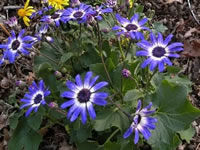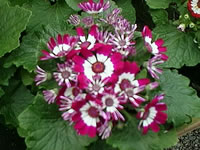How to Grow and Care for Cineraria Plants
Pericallis cruenta

Cinerarias are tender perennials that are only hardy in USDA zones 9-11, so they are most grown as annual plants, in greenhouses or as short lived, flowering house plants. Cineraria plants are native to the Canary Islands.
They form 12"-24" tall, mounded clumps of large, lush, bright green leaves that creates a nice accent for the vividly colored, Daisy-like 3"-5" flowers that stand above it in the spring and summer.
In mild winter regions where they are planted in the fall, Cinerarias will begin blooming in late winter.

Growing Requirements for Cinerarias
Cinerarias are not suited for growing in hot dry climates. If you are growing Cinerarias in the garden, they should be grown in partial to full shade, and planted in slightly acidic, rich, well-drained soil with a high compost content. Water regularly and thoroughly to keep the soil evenly moist, but never soggy. Cinerarias readily reseed themselves in the garden.
When grown in pots or planters, Cinerarias should be planted in a loose, rich, peat moss based potting mix with good drainage. Once they begin to bloom they prefer to be kept somewhat root-bound. Indoors, keep your Cineraria in filtered sun or bright light.Do not allow the soil to dry out, but be careful not to over water. Cinerarias like it cool, and will bloom for a much longer period with daytime temperatures of 65° and 50°-55° at night.
When the first buds begin to form, begin feeding your Cineraria every two weeks using a ½ strength solution of a soluble, bloom type fertilizer. Watch out for spider mites in the house, and slugs and snails in the garden!
Propagating Cinerarias and Growing them from Seed
- Cinerarias can be propagated with stem cuttings taken at any time during the summer months.
- Cineraria seeds require light for germination. Do NOT cover them!
- Sow seeds indoors, in flats on September 1st for blooming plants in time for Valentines Day, or on October 15th for Easter plants.
- Maintain a temperature of 70°-75° within the growing medium until germination, which takes 10-15 days.
- Use care to not overwater seedlings to avoid damping off fungus.
- After 4 weeks, transplant into 2½ pots. When the roots just begin to become crowded, transplant up to 5" pots for budding.
- Two weeks after transplanting to 5", move your Cinerareas to a bright, 50° area to induce budding. Once the first buds appear, feed with a ½ strength solution of a bloom type fertilizer and raise the temperature up to 65°.
Cineraria Pericallis cruenta


